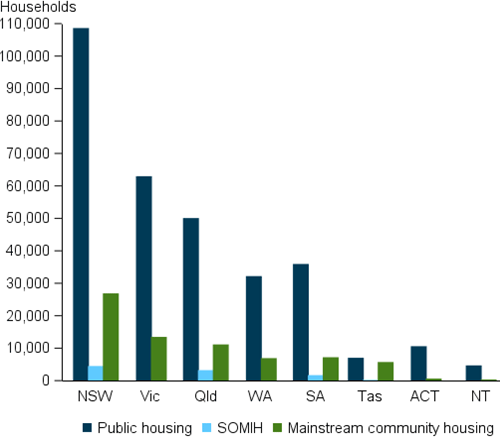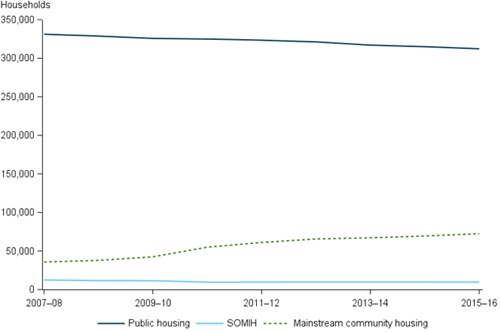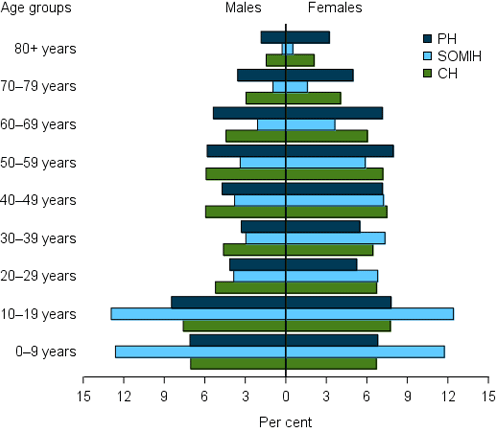Social housing tenants
- At 30 June 2016, there were around 845,400 tenants in social housing, with the majority (79%) of these in public rental housing.
- A total of 394,300 households made up Australia’s main social housing programs (public rental housing, SOMIH and mainstream community housing) in 2015–16, with the number of households in community housing more than doubling (up 103%) from around 35,700 in 2007–08 to 72,400 in 2015–16.
- Large proportions of social housing tenants are either older persons aged 55 years and over (33% for public rental housing and 27% for community housing) or children aged under 15 years (39% for SOMIH).
- Across all social housing programs, main tenants were more likely to be women (61%) while the largest proportion of households were single adults (55%).
- Four in ten public rental housing tenants had been in their tenancies for over 10 years.
Social housing includes all rental housing owned and managed by government or non-government organisations (including not-for-profit organisations) which can be let to eligible households. Social housing rents are generally set below market levels and are influenced by the income of the household.
Over recent years, social housing has increasingly been allocated to households with complex needs, such as to those living with disability and those on very low incomes. As at 30 June 2016, there were around 394,300 households in social housing, with the majority in public rental housing (312,200), 9,700 in state-owned and managed Indigenous housing (SOMIH) and 72,400 in community housing.
As at 30 June 2016, there were 17,600 dwellings making up the Indigenous Community Housing program (ICH) (household estimates are not available from that data collection).
Numbers of tenants in social housing
At 30 June 2016, there were around 845,400 tenants in social housing (complete data was not available for all programs in Queensland and the Northern Territory). Of these tenants, 79% or around 671,600 were in public housing; 4% or around 32,700 were in SOMIH; and, 17% or around 141,000 were in community housing. Of the 394,300 households living in social housing across Australia in 2016, over one third (35%) were located in NSW (Figure SHT.1).
Figure SHT.1: Number of social housing households by state and territory, at 30 June 2016

SOMIH = state-owned and managed Indigenous housing
Source: AIHW National Housing Assistance Data Repository 2015–16, Social housing tenants table TENANTS.2.
The number of public rental housing households has decreased from 331,100 in 2007–08 to around 312,200 in 2015–16 (a 6% fall).
SOMIH household numbers have also fallen during this time, from 12,400 to 9,700 (a fall of 22%).
In contrast, over the same time period, the number of community housing households has more than doubled. Between 2007–08 and 2015–16, the number of community housing households increased from 35,700 to 72,400 (a rise of 103%), with an increase of 4% in just the last 12 months (Figure SHT.2).
These changes reflect a gradual but steady shift of policy focus towards growing the community housing sector and transferring ownership or management of public rental housing stock to community housing organisations. The decrease in the number of public rental households over time was offset by an increase in community housing households. This shift in the distribution of housing stock reflects strategies to grow the community sector, as community housing can potentially provide more flexible and innovative affordable housing options [1].
Figure SHT.2: Number of social housing households, 2007–08 to 2015–16

SOMIH = state-owned and managed Indigenous housing
Source: AIHW National Housing Assistance Data Repository 2015–16, Social housing tenants table TENANTS.1.
Tenant demographics
Public rental housing tenants
The majority of main tenants in public housing households were female (62%), and just over half (54%) comprised of single adults living alone. Forty-three per cent reported a disability, although only 29% identified a disability support pension as their main source of income. A further quarter (25%) of tenants indicated an age pension as the main source of income.
A typical public housing main tenant can be described as an older female (55+) living alone.
SOMIH tenants
Of SOMIH households, three-quarters of main tenants were female (76%) and nearly two-thirds (64%) were aged 25–54 years. In terms of household composition, sole parents with dependent children were the largest family type (36%), followed by single adults (27%). Thirty-four per cent of SOMIH tenants reported having a disability.
A typical SOMIH main tenant can be described as a single female of working age (25–54) with dependent children.
Mainstream community housing tenants
Of community housing households, almost 6 in 10 of main tenants (58%) were female, and nearly 7 in 10 (67%) were aged 45 years and over. Single adults represented the highest proportion of household compositions (59%), followed by group and mixed households (16%). More than one-third (35%) of community housing tenants reported having a disability.
A typical community housing main tenant can be described as an older female (45+) living alone.
Age profile
In general, large proportions of social housing tenants are either older persons aged 55 years and over or children aged less than 15 years, although the proportions in these groups vary across the different social housing programs.
As at 30 June 2016, a relatively high proportion of tenants living in public rental housing, SOMIH and community housing households were children. Almost a quarter (22%) of public rental housing, 39% of SOMIH and 21% of community housing tenants were aged 0–14 years old.
The tenant age profile across social housing programs differs greatly. Where almost a third (33%) of public rental housing tenants and more than a quarter (27%) of community housing tenants were older, aged 55 years and over, only 13% of SOMIH tenants fell in this age group while over a third (39%) were children aged 0–14 years (Figure SHT.3).
Figure SHT.3: Age and sex distribution of tenants in public rental housing, SOMIH and mainstream community housing, at 30 June 2016

CH= mainstream community housing; PH = public housing; SOMIH = state-owned and managed Indigenous housing
Source: AIHW National Housing Assistance Data Repository 2015–16, Social housing tenants table TENANTS.7 .
Tenants’ length of tenure
A substantial proportion of households in public rental housing and SOMIH remain in tenure for long periods of time (Table SHT.1). As at 30 June 2016, 42% of public rental housing and 34% of SOMIH households had been in the same tenancy for over a decade. Most tenancies had been in place for over 5 years for public rental housing households (63%) and SOMIH households (57%). It is worth noting, however, that around one in five tenancies remain in place for less than a year (18% for PH and 22% for SOMIH). Comparable data are not currently available for community housing.
| Public housing number |
Public housing per cent |
SOMIH number |
SOMIH Per cent |
|
|---|---|---|---|---|
| 6 months or less | 14,257 | 4.6 | 540 | 5.6 |
| Over 6 months to 1 year | 40,865 | 13.1 | 1,583 | 16.4 |
| 2 to 4 years | 59,007 | 18.9 | 2,077 | 21.5 |
| 5 to 9 years | 65,606 | 21.0 | 2,213 | 22.9 |
| 10 to 19 years | 84,418 | 27.0 | 2,220 | 23.0 |
| 20 to 29 years | 36,210 | 11.6 | 733 | 7.6 |
| 30 or more years | 11,856 | 3.8 | 294 | 3.0 |
SOMIH = state-owned and managed Indigenous housing
Notes
- Records with missing start date have been excluded.
- Data are for ongoing households; therefore tenure length has been calculated using the tenancy start date and an end date of the 30th June of the financial year.
- Data on mainstream community housing tenure length were not available.
Source: AIHW National Housing Assistance Data Repository, 2015–16.
Nationally, 2% of public rental housing tenants and 3% of SOMIH tenants transferred to a different dwelling during 2015–16. This may have been due to state and territory housing authorities seeking to match tenant characteristics to household size. For example, by moving a single tenant household into a smaller dwelling to make room for a larger family household on the wait list, or tenants requesting relocation to a different geographic area. Households leaving social housing (as measured by exit rates) were slightly higher in 2015–16 than transfer rates, with 7% of public rental tenants and 8% of SOMIH tenants ending their tenancies during the year.
References
- Pawson H, Martin C, Flanagan K and Phillips R 2016. Recent housing transfer experience in Australia: implications for affordable housing industry development, AHURI Final Report No. 273. Melbourne: AHURI. doi:10.18408/ahuri-7108101


